
table of contents
- Dwarf shrubs with red foliage
- Medium-high shrubs
- Tall bushes
- Types from A - J
- Types of K - Z
- Large shrubs
- frequently asked Questions
With the beginning of spring it is getting greener and more and more colorful outside. Not only flowers provide color, but also shrubs with red leaves in a wide variety of nuances.
In a nutshell
- Red color when budding, year-round or as a bright red autumn color
- The vegetable dye anthocyanin is responsible for the color
- red leaves contain more dye than chlorophyll
- green leaf color is practically hidden under the red tones
- Red-leaved plants offer numerous combination and design options
Dwarf shrubs with red foliage
Purple branch 'Purpurea' (Weigela florida)

- Slow growing, richly flowering shrub
- Overhanging, bushy growth
- Height 120-150 cm
- Leaves initially reddish, later turning green
- Flowering period from late May to June
- Small, bell-shaped, dark pink flowers
Belt flower 'Fire Dance' (Loropetalum chinense)

- Heavily branched, bushy, dense and fragrant shrub
- Growth height 70-150 cm
- Leaves ovate, dark red, shiny
- Pink, strap-shaped petals
- Blooms from March to April
- Exotic-looking, fragrant, bright pink flowers
sage 'Purpurascens' (Salvia officinalis)

- Cushion-like growth, woody at the base
- Growth height 30-60 cm
- Elongated purple-purple leaves
- Blooms from June to August
- Spike-shaped, violet-blue flowers
- Leaves and flowers give off a delicate, pleasant scent
Grape heather 'Scarletta' (R) (Leucothoe axillaris)

- Flat, compact and overhanging growth
- About 40-50 cm high
- Shoots bronze-colored, later gradually turning green
- Intense red in autumn and winter
- Blooms from May to June
- Delicately fragrant, white flower clusters
Medium-high shrubs
Dark red maple 'Garnet' (Acer palmatum)

- Slow growing shrub
- Ideal for keeping in a bucket
- Growth height up to 150 cm
- Purple, deeply slit foliage
- Turns bright red in autumn
Tip: Japanese maples come with different leaf shapes and colors. The red-leaved varieties include the 'Shaina', 'Inaba shidare' and 'Pung Kil' varieties.
Northern pike rose, red-leaved (Rosa glauca)
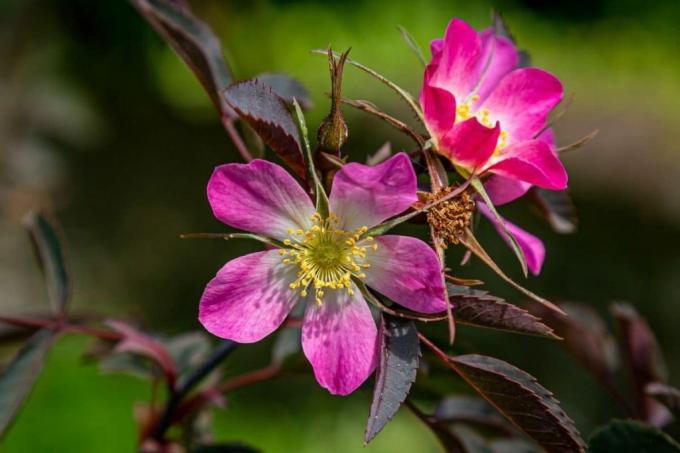
- One of the most beautiful hedge plants
- Loosely upright with overhanging shoots
- Leaves bluish-green, turning purple, frosted
- Brown-red shoots, frosted pale blue
- In June / July pink flowers with a pretty color gradient
Tip: The pike rose Rosa glauca supplies vitamin C-rich rose hips from September. It also attracts birds and insects into the garden.
Red-leaved columnar lilacberry 'Black Tower'(R) (Sambucus nigra)
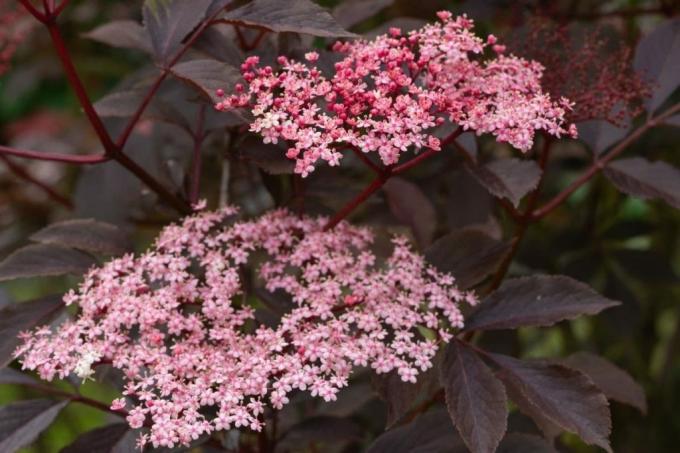
- Grows compact and columnar, up to 200 cm high
- High-contrast, glossy black-red foliage
- Flowers from June to July
- Simple, umbel-shaped with a pink and white pattern
- Carries tasty berry fruits
Shadow bells 'Mountain Fire' (Pieris japonica)

- Compact, slow-growing small shrub
- Heights between 120 and 160 cm
- Different shades of red in the shoot
- Long-lasting red color, only later turning green
- Blooms from late March to May
- Flowers white and panicle-shaped
- Protected location
Tall bushes
Types from A - J
Blood barberry 'Atropurpurea' (Berberis thunbergii)

- Grows upright, very dense, slightly overhanging shoots
- Studded with thorns
- Very frost hardy and cut resistant
- Up to 300 cm high
- Dark red leaves turn bright red in autumn
- Blooms from May to June
- Small, simple, yellow-red clusters of flowers
- Red fruit decorations in autumn
Double flower (Disanthus cercidifolius)

- Dense upright shrub, good frost resistance
- Growth height up to 300 cm
- Heart-shaped, blue-green leaves
- In autumn in the most beautiful shades of red
- Late flowering from October to November
- Star-shaped purple-violet flowers
Dark red bladder spar 'Diabolo' (R) (Physocarpus opulifolius)

- Grows upright and bushy
- Heights of growth of 200-300 cm
- Dark red foliage, orange-red autumn colors
- Flowering time from May to July
- Strongly contrasting white flower umbels
Tip: This dark red bubble spar is a great color addition to green hedges or in front of light walls.
Loquat 'Red Robin' (Photinia fraseri)

- Grows loosely upright to broadly bushy
- Heights between 150 and 300 cm
- Leaves bright red when they shoot
- Later changes to coppery-green
- From May to June white flowers in the form of panicles
- Fruits not suitable for consumption
- Winter protection recommended
Tip: Due to the limited winter hardiness, you should pay attention to a location protected from the wind.
Types of K - Z
Canadian Judas Tree 'Ruby Falls' (Cercis canadensis)

- Exceptional cultivation of the Judas tree
- Ornamental shrub or small tree
- Heights of growth 200-400 cm
- Flowers appear before leaves shoot
- Bright pink, butterfly-like
- Sit directly on twigs and branches
- Leaves heart-shaped and deep red, very contrasting
- Orange impact in autumn
Tip: Younger specimens are grateful for light winter protection.
Royal Purple wig bush (Cotinus coggygria)

- Broad bushy, spreading growth, up to 300 cm high
- Intense black-red foliage
- Flowering period from June to July
- Blossom at the same time fruit decoration
- Initially greenish, then brownish panicles up to 15 cm in size
- Then wig-like, silvery-reddish fruit clusters
Purple hazel 'Purpurea' (Corylus maxima)

- Initially stiffly upright, in old age umbrella-like, bushy
- Between 200 and 300 cm high
- Flowers before leaves shoot in March / April
- Leaves bright red when they shoot
- Constantly black and red throughout the summer
- Round, edible nuts in autumn
Red-leaved Corkscrew hazel 'Red Majestic' (Corylus maxima)
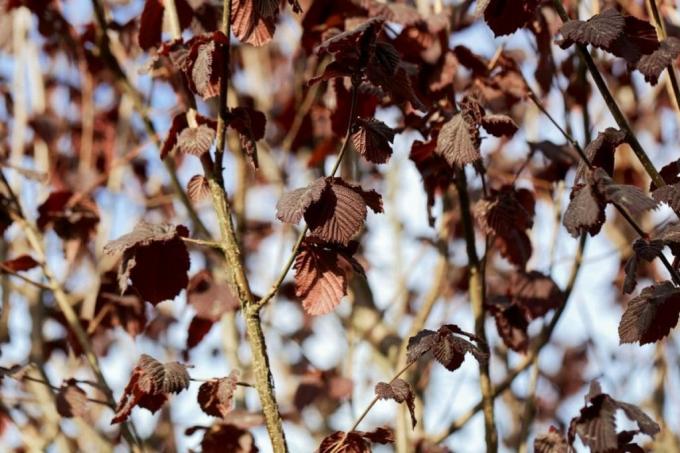
- Grows upright, bushy, multi-stemmed
- Corkscrew-like twisted shoots, rare variant
- Between 200 and 250 cm high
- Dark purple shoots, then reddish leaves
- Flowering period February to March
- Red, elongated kittens
Dwarf blood plum (Prunus cistena)
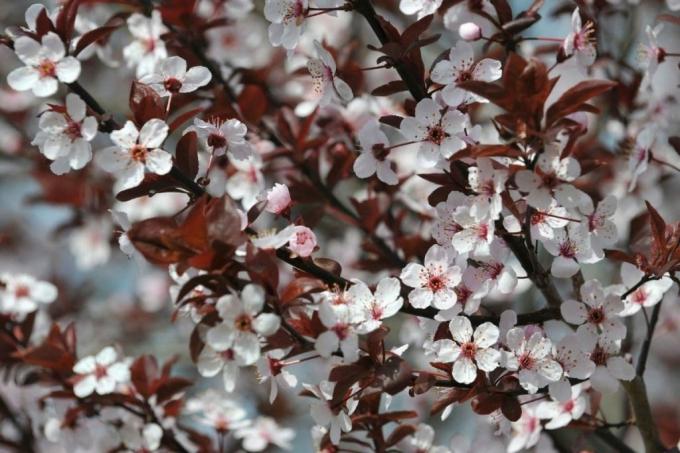
- Slow, upright, multi-stemmed growth
- Heights of growth 150-250 cm
- Dark red foliage, slightly shiny
- Blooms from late April to May
- Small, simple, radial pink-white flowers
- Dark red, edible fruits
Large shrubs
Purple sloe 'Purpurea' (Prunus spinosa)
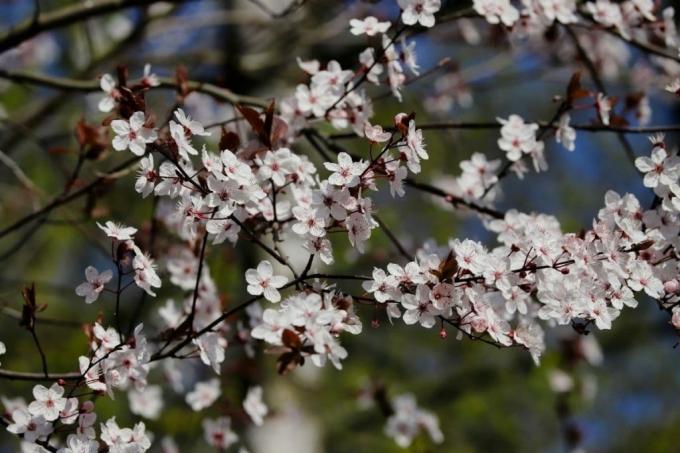
- Upright, bushy, heavily branched growth
- Heights up to 500 cm
- Shoots purple-red, later red-green
- Orange in autumn
- Flowers from April to May
- Flowers star-shaped, pale pink, directly on the branches
Tip: The sloe forms spherical, blue-frosted, edible fruits. Their taste is sweet and sour.
Red-leaved cell nut (Corylus avellana)

- Medium strong, broadly upright, well branched growth
- Heights of growth of 300-600 cm
- Red-leaved when shooting, greening over summer
- Blooms from March to April
- Inconspicuous, elongated reddish kittens
- Edible, reddish hazelnuts in autumn
Tip: For better pollination it is advisable to plant two or more specimens.
Red-leaved clove cherry 'Royal Burgundy' (Prunus serrulata)
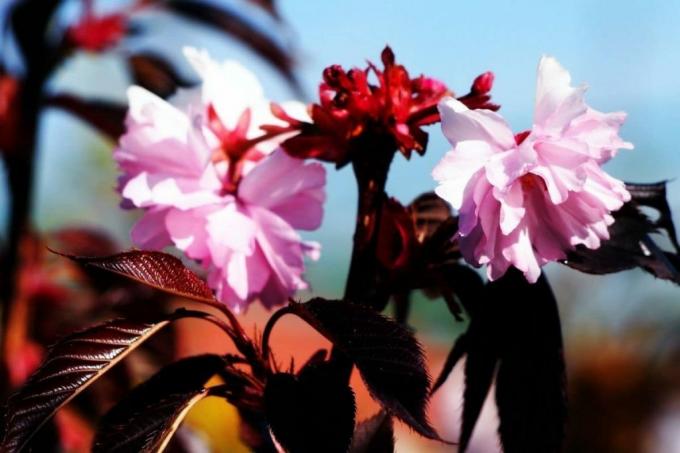
- Elegant ornamental foliage plant with a Far Eastern flair
- Large shrub with a funnel-shaped crown
- Heights of growth 400 to 700 cm
- Leaves deep purple to purple-red
- Magnificent bronze-orange to copper-brown in autumn
- Flowering period from the end of April to May
- Small double, umbel-shaped, dark pink flowers
Ornamental apple 'Rudolph' (Malus)

- Grows as a large shrub or small tree
- Slender, upright growth habit
- Up to 600 cm high
- Attractive brownish-red foliage
- Special splashes of color during flowering from May to June
- Simple, pink, bowl-shaped flowers
- From September small, yellow-orange ornamental apples
Tip: This crab apple is very suitable as a pollinator for nearby apple trees.
frequently asked Questions
Basically, they are best placed in a sunny place. The further they are in partial shade or shade, the more green the leaves become.
Often these shrubs are excellent specimen trees thanks to their coloring or their contrasting flowers. They give the garden structure and height. You can combine different varieties and heights of growth or use lower-growing shrubs and other accompanying plants as foreground planting. Some red-leaved shrubs are also suitable for group planting or as hedge plants.
Deciduous trees need basic fertilization in spring, for example in the form of horn shavings. Flowering shrubs are supported with a liquid fertilizer during flowering. Fertilization shortly before winter should generally be avoided as it increases susceptibility to frost.
